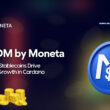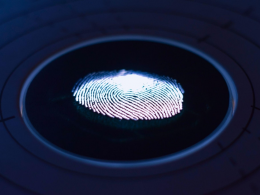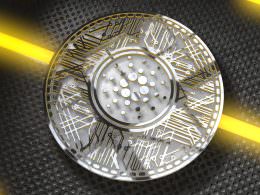Interoperability can be applied to cryptocurrencies, fungible tokens, as well as non-fungible tokens (NFTs).
It is important to define interoperability. Transmitting certain information is not the same as sharing the ledger bidirectionally, as full interoperability would be a merger of two blockchains.
The interoperability that is usually spoken of is the transmission of specific information, resulting from an output of one blockchain to be input into another, each maintaining its own ledger.
Cross-chain technology, the most common interoperability technology, seeks the transmission of securities, tokens or smart contracts between different networks, with communication without intermediaries. A cross-chain bridge is a connection between two blockchains, a practical realization of blockchain interoperability without sharing the ledger.
Most bridges work with a burn-and-issue protocol, meaning that when a token is transferred from one blockchain to another, the underlying protocol first burns the token and then mints an equivalent token, on the other blockchain.
Other protocols work with token wrapping, leaving the issued token blocked on the source network and generating a wrapped token on the destination network.
Either of these two ways ensure that, throughout the blockchain ecosystem, policies are respected so that there are no duplicate values.
In the past few months, NFTs have been the talk of the town among technology experts, industry and the art world. Even the traditional media, outside the industry, have covered the feverish debate around the possibility of digitally representing assets in a distributed ledger, and trading them as so-called NFTs on specific platforms.
Virtually anything can be digitized and represented as an NFT. Digital assets such as digital artwork, video clips, music, or gaming items can be represented and traded as NFTs, as well as physical assets such as real estate, paintings, or vintage cars. Thanks to the underlying DLT, the ownership of an NFT is digitally certified, and can only be modified (either by transferring or destroying it) by the owner.
Many new use cases are only possible through the digitized representation of digital asset ownership. For example, it is possible to program tokens with a royalty function, so that when an artist sells his or her art and the work is subsequently resold, he or she receives a predetermined royalty. In addition, NFTs retain their uniqueness, making them an excellent solution for digitizing the collectibles market, where there is proof of ownership and protection against copyright infringement.
Unfortunately, current NFT solutions also have some significant drawbacks.
For example, the current process for getting your NFT to a buyer is extraordinarily expensive. Typically, the process carries a minting fee to create the NFT, listing it on a platform costs an additional fee, the NFT platform typically asks for a commission on sales, and the actual transaction on the blockchain also carries fees.
IOTA NFTs
IOTA is a transaction settlement and data transfer network for the Internet of Things (IoT). Its distributed ledger, the Tangle, is based on a data structure called a directed acyclic graph (DAG). There are no blocks or miners in the Tangle, and each transaction on the IOTA network must validate two previous transactions through a small proof of work (PoW). Thus, the more transactions that occur, the faster the network can process new transactions, theoretically allowing the network to become more efficient as it expands.
The IOTA NFT marketplace, developed by the IOTA community, and launched on July 15, 2021, on the IOTA 2.0 DevNet, illustrates without a doubt that the future of digital assets, including NFTs, is near feeless, decentralized, green and accessible to all.
Although currently only available in test mode, IOTA’s new community-built NFT marketplace promises a more accessible future for NFTs. Transactions are very low on the IOTA network, and minting fees are also negligible due to IOTA’s digital asset framework. Only the IOTA NFT marketplace fee remains, as the infrastructure has to be powered somehow. Ultimately, the NFT solution based on the IOTA network will be significantly cheap and therefore more attractive to all market participants.
The developers of NFT-MAKER PRO saw this market, and have a proposal.
The Bridge-building Approach
The NFT-MAKER.IO PRO version features backend tools and services for brands, companies and creators to help them create white-label NFT solutions. You can create, manage and sell your NFTs.
NFTs mostly live in a chain, which makes it very difficult to incorporate new users, especially when they already own NFTs in other chains.
The developer team’s proposal is to build a bridge between Cardano and IOTA for NFTs, and integrate it into the NFT-MAKER PRO developer API.
To achieve widespread adoption of NFTs, it is clear that NFTs cannot live on a blockchain alone. Therefore, they propose to build an easy-to-use NFT bridge that is implemented in the NFT-MAKER PRO API. Using this API, users will be able to easily move their NFTs from one chain to another and vice versa.
Roadmap
They promise to have the bridge operational in NFT-MAKER PRO, after 4 months of receiving funding, if chosen.
Using the NFT-MAKER PRO API, or user interface, users will be able to generate block endpoints for their NFT, and have the NFT reprinted on another chain in a wrapped format.
Funding requested: USD 50,000
The Developers
The team develops NFT-MAKER and NFT-MAKER PRO – the two most widely used NFT creation tools at Cardano.
At Catalyst’s FUND5 they won the proposal to evolve the NFT-Maker platform, with funding of USD 40,000. You can read the article I wrote: A Full NFT Platform: Nft-maker.io.
Developer: Patrick Tobler, BABEL SPO, founder of nft-maker.io, and computer science student. In the Cardano space since 2017.
Designer: Fahim Popalzai, co-founder of nft-maker.io, and lead designer.
Product designer: Peter Jaschkowske, the man between development and design. IoT student at the Hochschule für Gestaltung in Schwäbisch Gmünd. He deals with the user experience of technology and graphics.
The platform: https://www.nft-maker.io/pro
This original proposal is at Catalyst.










